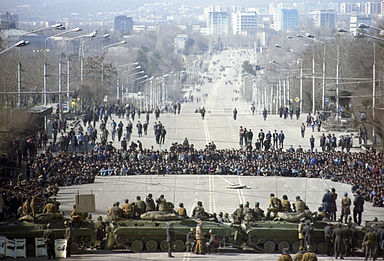1990 Dushanbe riots
The 1990 Dushanbe riots were an anti-government unrest in Dushanbe, the capital of Tajikistan, from February 12–14, 1990.
| 1990 Dushanbe riots | |
|---|---|
| Part of Dissolution of the Soviet Union | |
 BMPs in the Lenin prospect in Dushanbe, 14 February 1990. | |
| Location | |
| Date | February 12–14, 1990 |
| Target | Armenian, Russian & Tajik civilians |
Attack type | anti-government riots |
| Deaths | 26 |
| Injured | 565 |
| Perpetrators | Tajik nationalist & Islamist activists |
Part of a series on the |
|---|
| History of Tajikistan |
| Timeline |
|
|
History
In 1988, in the aftermath of the Sumgait pogrom and anti-Armenian riots in Azerbaijan, 39 Armenian refugees were temporarily resettled from Azerbaijan to Dushanbe.[1] In 1990, the Armenian influx became a subject of the rumour that triggered riots in Dushanbe.[2] The rumour inflated the number of refugees to 2,500–5,000.[1] According to rumour Armenians allegedly were being resettled in new housing in Dushanbe,[1] which was experiencing an acute housing shortage at that time.[1][3] Despite the fact that Armenian refugees resettled not in public housing but with their relatives, and by 1990 already left Tajikistan for Armenia,[1] official denouncement of the rumours was not able to stop the protests. Assurances by Communist Party First Secretary Qahhor Mahkamov that no resettlement of Armenians was taking place were rejected by the demonstrators.[4]
Soon, demonstrations sponsored by the nationalist Rastokhez movement turned violent.[4] Radical economical and political reforms were demanded by the protesters.[4] Government buildings, shops and other businesses were attacked and looted. Armenians, Russians,[5] and other ethnic minorities were targeted. Abuse of Tajik women wearing European clothes in public also took place. The riots were put down by Soviet troops that were called into Dushanbe [6] by Mahkamov. However Mahkamov's over reliance on military force was criticized by Buri Karimov, a deputy chair of Council of Ministers, who called for the resignation of the leadership of the Tajik Communist Party. On February 14, 1990 Mahkamov and Prime Minister of Tajikistan Izatullo Khayoyev submitted their resignations, but they were not accepted by the Central Committee of the Tajik Communist Party.[4]
During the Dushanbe riots, a period lasting a couple of days, 26 people were killed and 565 were injured.[4] Among the Tajik youth activists convicted for participation in the riots was a future minister of the interior of Tajikistan Yaqub Salimov.[7] Smaller scale anti-Armenian incidents were also recorded in another Soviet Central Asian Republic, Turkmenistan.[8]
See also
- Civil war in Tajikistan
References
- Horowitz, Donald L. (2002). The Deadly Ethnic Riot. University of California Press. p. 74. ISBN 0-520-23642-4. Retrieved 2008-10-23.
- Michael Waller; Bruno Coppieters; Alekseĭ Vsevolodovich Malashenko, eds. (1998). Conflicting Loyalties and the State in Post-Soviet Russia and Eurasia. Routledge. pp. 169–170. ISBN 0-7146-4882-5.
- Payin, Emil. "Settlement of ethnic conflicts in post-Soviet society". United Nations University Press. Retrieved 2008-10-23.
- Takeyh, Ray; Nikolas K. Gvosdev (2004). The Receding Shadow of the Prophet. Greenwood Publishing Group. ISBN 0-275-97629-7.
- Kolstø, Pål; Andrei Edemsky (1995). Russians in the Former Soviet Republics. Indiana University Press. p. 213. ISBN 0-253-32917-5.
- Collins, Kathleen (2006). Clan politics and regime transition in Central Asia. Cambridge University Press. pp. 155. ISBN 0-521-83950-5. Retrieved 2008-10-23.
Dushanbe riots islamists.
- ГАФАРЛЫ, МЕХМАН (2004-02-25). На родину в наручниках Россия экстрадировала в Душанбе бывшего главу МВД Таджикистана Якуба Салимова (in Russian). Novye Izvestiya. Archived from the original on 2010-03-13. Retrieved 2008-10-23.
- Allworth, Edward (1994). Central Asia, 130 Years of Russian Dominance. Duke University Press. pp. 586–587. ISBN 0-8223-1521-1. Retrieved 2008-10-23.